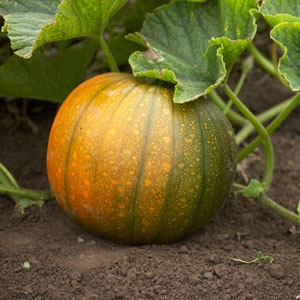To all the lovely people,
Here is ashore article from the people at Organic Gardening about storing squash. It is worth reading if you grow winter squash.
We grew some very nice Warted Hubbard as well as large, heavy, and thick meated.
Paul
Harvesting & Storing Squash
Welcome winter with a nutritious cache of squash in the cellar.
By Doug Hall
Pumpkins and their kin, the winter squashes, take months to mature. Don't rush the process; a squash's hard, protective skin develops with time. If you're growing them for storage, wait until the vines begin to dry and the rinds have toughened before harvesting. To test for maturity, press a thumbnail against the skin; your nail shouldn't leave a visible dent.
It's best to time a squash crop so the fruits can be harvested and put into storage before frost, which can compromise shelf life. If hard frost threatens before pumpkins or squashes are ripe, blanket the fruits and vines with a tarp or loose straw.
Cut, don't pull, ripe squashes from the vines, leaving 3 inches of stem. A broken stem exposes the fruit to rot, so don't use the stem as a “handle” for carrying. Cure harvested squash, unwashed, in a warm and sunny spot for a week or two. (Skip the curing step for acorn squash, which can become stringy if it's not moved to a cool place immediately after harvest.) Take care to protect the fruits from cuts, scrapes, and dents, as all can lead to early spoilage.
Unlike tender-skinned summer squashes, which must be eaten within a few days of harvest, winter squashes can last up to 8 months in storage. Store cured squashes in a room that is dry and cool—but no cooler than 50°F—and make sure they have good air circulation.
Growing conditions affect the length of time a squash keeps its quality in storage. Those that were grown with abundant moisture and fertilizer, for example, or exposed to frost before harvest, will deteriorate sooner.
In general:
- Thinner-skinned types such as acorn, delicata, and spaghetti squashes should be used within a month or two of harvest.
- Hubbard and buttercup squashes and pie pumpkins can be stored for up to 4 months.
- Butternuts and cushaws keep best in storage, sometimes lasting until spring.
The tough skin that allows for lengthy storage can be a challenge when it's time to prepare a squash for eating. If your heftiest kitchen knife fails, reach for a hacksaw.
As you prepare a winter squash for cooking and scoop away its stringy insides, you may be tempted to save and dry a few seeds for next year's garden. But if you grew more than one type of squash and left their pollination up to the bees, it's quite likely that the next generation will be nothing but mongrels.
Photo: Will Heap/Getty Images
